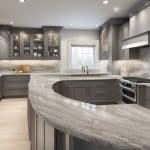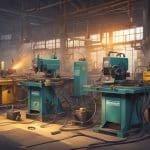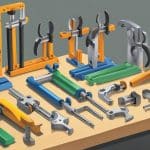Types Of Metal Roofing
Metal roofing has become increasingly popular in recent years due to its durability, longevity, and energy efficiency. Unlike traditional roofing materials like asphalt shingles, metal roofing is made from durable materials like steel, aluminum, and copper, which can last up to 50 years or more with proper maintenance. In addition, metal roofing is resistant to fire, wind, and hail, making it a popular choice for homeowners in areas prone to severe weather.
One of the advantages of metal roofing is that it comes in a variety of types and styles, each with its own unique advantages and disadvantages. Some of the most common types of metal roofing include standing seam, corrugated, and metal shingles. Standing seam roofing is a popular choice for its sleek, modern look and durability, while corrugated roofing is a more affordable option that is ideal for industrial or agricultural buildings. Metal shingles, on the other hand, are designed to mimic the look of traditional roofing materials like slate or wood, making them a popular choice for homeowners who want the look of a traditional roof with the durability of metal.
Key Takeaways
- Metal roofing is a durable and energy-efficient option that can last up to 50 years or more with proper maintenance.
- There are several types of metal roofing materials available, including standing seam, corrugated, and metal shingles, each with its own unique advantages and disadvantages.
- Homeowners should consider factors like installation and maintenance costs, aesthetic preferences, and environmental impact when choosing a type of metal roofing.
Advantages of Metal Roofing

When it comes to roofing materials, metal roofing has become increasingly popular in recent years. This is due to a number of advantages that metal roofs offer over other types of roofing materials. In this section, we will discuss some of the key advantages of metal roofing.
Durability and Longevity
One of the most significant advantages of metal roofing is its durability and longevity. Unlike other roofing materials, such as asphalt shingles, metal roofing can withstand extreme weather conditions, including heavy rain, hail, and high winds. Metal roofing is also fire-resistant, which makes it an ideal choice for areas prone to wildfires.
In addition to its durability, metal roofing is also known for its longevity. Metal roofs can last for up to 50 years or more, which is significantly longer than other types of roofing materials. This means that homeowners can save money in the long run by not having to replace their roof as often.
Energy Efficiency and Sustainability
Another advantage of metal roofing is its energy efficiency and sustainability. Metal roofs are known for their ability to reflect solar energy, which helps keep homes cooler in the summer and reduces energy costs. This is especially important in warmer climates where air conditioning costs can be high.
Metal roofing is also a sustainable choice for homeowners who are concerned about the environment. Many metal roofs are made from recyclable materials, which means that they can be reused or repurposed at the end of their lifespan. This makes metal roofing an eco-friendly choice for those who are looking to reduce their carbon footprint.
Aesthetic Variety
Finally, metal roofing offers a wide range of aesthetic options for homeowners. Metal roofs come in a variety of colors and styles, which means that homeowners can choose a roof that complements the style of their home. This is especially important for homeowners who are looking to increase the curb appeal of their home.
In conclusion, metal roofing offers a number of advantages over other types of roofing materials. From its durability and longevity to its energy efficiency and sustainability, metal roofing is a great choice for homeowners who are looking for a long-lasting and eco-friendly roofing solution.
Types of Metal Roofing Materials
When it comes to metal roofing, there are several different materials to choose from. Each type of metal roofing material has its own unique properties, benefits, and drawbacks. Here are some of the most common types of metal roofing materials:
Steel Roofing
Steel is one of the most popular materials for metal roofing. It is strong, durable, and relatively affordable. Steel roofing comes in a variety of styles, including corrugated metal, standing seam metal, metal shingles, metal slate, and metal tiles. It is also available in a range of colors and finishes.
Aluminum Roofing
Aluminum is another popular material for metal roofing. It is lightweight, rustproof, and reflects heat well. Aluminum roofing is available in a range of styles, including standing seam metal, metal shingles, and metal tiles. It is also available in a variety of colors and finishes.
Copper Roofing
Copper is a premium material for metal roofing. It is durable, long-lasting, and has a unique look that many homeowners find attractive. Copper roofing is available in a variety of styles, including standing seam metal, metal shingles, and metal tiles. It is also available in a range of natural colors that will patina over time.
Zinc Roofing
Zinc is a durable and long-lasting material for metal roofing. It has a unique look that many homeowners find appealing. Zinc roofing is available in a variety of styles, including standing seam metal, metal shingles, and metal tiles. It is also available in a range of colors and finishes.
Tin Roofing
Tin is a classic material for metal roofing. It is lightweight, durable, and relatively affordable. Tin roofing is available in a variety of styles, including corrugated metal and standing seam metal. It is also available in a range of colors and finishes.
In summary, when it comes to metal roofing, there are many different materials to choose from. Each type of metal roofing material has its own unique properties, benefits, and drawbacks. Homeowners should carefully consider their needs and budget when choosing a type of metal roofing material.
Metal Roofing Systems
When it comes to metal roofing, there are several different systems to choose from. Each system has its own advantages and disadvantages, and the choice ultimately depends on the specific needs of the building and the budget of the owner. In this section, we will discuss the three most common metal roofing systems: standing seam metal roofing, exposed fastener metal roofing, and stone-coated metal roofing.
Standing Seam Metal Roofing
Standing seam metal roofing is a popular choice for commercial and residential buildings alike. This system consists of standing seam panels that are connected by concealed fasteners. The panels are joined together by interlocking seams, which provide a sleek and modern look. Standing seam metal roofs are known for their durability and longevity, with some roofs lasting up to 50 years or more.
Exposed Fastener Metal Roofing
Exposed fastener metal roofing is another popular option for commercial and residential buildings. This system consists of metal roofing panels that are attached to the roof deck with metal roofing fasteners. The fasteners are visible on the surface of the roof, which gives this system its name. Exposed fastener metal roofing is generally less expensive than standing seam metal roofing, but it is also less durable and has a shorter lifespan.
Stone-Coated Metal Roofing
Stone-coated metal roofing is a newer type of metal roofing that has become increasingly popular in recent years. This system consists of metal roofing panels that are coated with a layer of stone chips. The stone coating gives the roof a more traditional look, while still providing the durability and longevity of a metal roof. Stone-coated metal roofing is generally more expensive than other types of metal roofing, but it is also more durable and has a longer lifespan.
In conclusion, when it comes to metal roofing systems, there are several options to choose from. Each system has its own advantages and disadvantages, and the choice ultimately depends on the specific needs of the building and the budget of the owner. Standing seam metal roofing, exposed fastener metal roofing, and stone-coated metal roofing are the three most common systems, and each offers a unique set of benefits.
Installation and Maintenance
Installation Process
Installing a metal roof requires a skilled contractor with experience in metal roofing. The installation process involves the following steps:
- Measuring the roof to determine the amount of material required.
- Preparing the roof surface by removing old roofing materials, repairing any damage, and installing a moisture barrier.
- Installing the metal panels, starting at the eaves and working upwards. The panels are secured to the roof deck using screws or clips.
- Installing the flashing around roof penetrations, such as chimneys and vents.
- Finishing the roof edges with trim pieces.
The labor cost for metal roof installation is typically higher than for other roofing materials due to the specialized skills required. However, a metal roof can last up to 70 years with minimal maintenance, making it a cost-effective choice in the long run.
Maintenance and Repairs
One of the advantages of a metal roof is its easy maintenance. It requires minimal upkeep to keep it in good condition. Regular inspections should be performed to identify any potential issues, such as loose screws or damaged panels. Any necessary repairs should be made promptly to prevent further damage.
If a metal roof does require repairs or replacements, it is important to hire a contractor with experience in working with metal roofing. They will have the knowledge and tools necessary to make the repairs correctly and ensure the roof remains watertight.
In summary, a metal roof is a durable and long-lasting roofing option that requires minimal maintenance. While the initial labor cost may be higher than other roofing materials, the cost is offset by the longevity of the roof. Regular inspections and prompt repairs will help prolong the life of the roof and prevent costly damage.
Cost and Considerations
When it comes to choosing a metal roofing system, cost is an important factor to consider. While metal roofing can be more expensive than traditional asphalt shingles, it is a long-term investment that can offer significant benefits.
Initial Investment
The initial investment for a metal roof can vary depending on the type of metal used, the size of the roof, and the complexity of the installation. According to HomeGuide, the average cost of a metal roof installation is between $7,500 and $40,000, with costs ranging from $5 to $16 per square foot for materials and $4 to $8 per square foot for labor.
While the initial investment for a metal roof may be higher than traditional roofing options, it is important to consider the long-term savings that come with a lifetime roof. Metal roofs are durable and require minimal maintenance, which can save homeowners money on repairs and replacements over time.
Long-Term Savings
One of the biggest advantages of a metal roof is its long-term savings potential. Metal roofs can last 50 years or more, compared to the 15-20 year lifespan of traditional asphalt shingles. This means that homeowners can save money on repairs and replacements over the lifetime of their roof.
In addition to the cost savings, metal roofs can also offer a return on investment in the form of energy savings. Metal roofs are reflective and can help keep homes cooler in the summer, reducing the need for air conditioning. This can lead to lower energy bills and increased home resale value.
When considering a metal roof, it is important to choose a reputable installer and to review the warranty carefully. Many metal roofing systems come with a lifetime warranty, which can provide peace of mind and protection for homeowners.
Aesthetic and Environmental Impact
Metal roofing is a popular choice among homeowners due to its aesthetic appeal and environmental benefits. With a variety of design and style options, metal roofing can provide a beautiful and modern look to any home.
Design and Style Options
Metal roofing comes in a wide range of colors and styles, including traditional shingles and modern paneling. This allows homeowners to choose a design that fits their personal style and complements the overall look of their home.
In addition to its design versatility, metal roofing is also lightweight, making it an ideal choice for homes that cannot support the weight of traditional roofing materials. Its extended lifespan also makes it a cost-effective option in the long run.
Environmental Benefits
Metal roofing is made from recyclable materials, which means that it is an eco-friendly option for homeowners. Additionally, metal roofing can help reduce energy costs by reflecting sunlight and keeping homes cooler in the summer months.
Furthermore, metal roofing is a sustainable choice for homeowners as it is made from recycled materials and has a long lifespan, reducing waste and the need for frequent replacements. This contributes to green building practices and environmental stewardship.
Overall, metal roofing is a stylish and sustainable option for homeowners who are looking to improve the aesthetic appeal of their home while also reducing their environmental impact.






